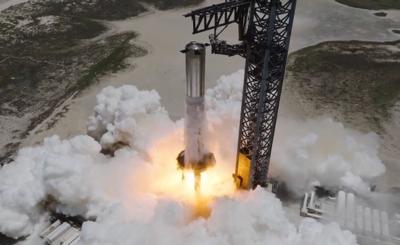Inklings of a Second Starship Launch
On Sunday, 06 August 2023, Space Exploration Technologies Corporation—known throughout the world as SpaceX, the American spacecraft manufacturer, launch-service provider, and satellite communications company headquartered in Hawthorne, California and owned by enigmatic multi-billionaire and Tesla-founder Elon Musk—performed a static-fire test of a new Super Heavy booster at its Boca Chica, Texas Starbase launch facility.

While the ignition of 33 Raptor rocket engines proved a memorable spectacle; the test-firing yielded both favorable and unfavorable results.
Dubbed Booster-9—insomuch as it’s the ninth such first-stage to be built under SpaceX’s iterative design ethos—the booster survived the test, appearing afterward to have borne the flame and fury of its plethora of constituent engines admirably.
Moreover, the modifications made by SpaceX to the Starbase launch-platform—which include a rebuilt launch-pad and an enhanced flame-suppression system comprising a massive, perforated steel plate through which jets of water emit—seemingly endured the Super Heavy booster test-firing with aplomb.
Perspicacious readers will recall the 20 April 2023 test-launch of SpaceX’s mammoth Starship vehicle blasted the original Boca Chica launch-pad more-or-less to oblivion.
The aforementioned positives notwithstanding, the Super Heavy test-firing fell short of its planned five-second duration, terminating after only 2.74-seconds. Moreover, four of the stage’s 33 Raptor main-engines shut down prematurely, thereby indicating SpaceX is struggling, still, with the reliability of its proprietary engines.
Booster-9 is powered by Raptor 2 engines; currently, SpaceX is working on an upgraded Raptor 3 iteration of the chemical rocket engine in the hope of improving the powerplant’s reliability.
The Booster-9 test-firing heralded the second launch of SpaceX’s Starship. Whether or not additional test-firings of the mighty first-stage will be undertaken prior to such an attempt remains unknown, as does the imminence of a second Starship launch. Seventy-days elapsed between the static test-firing of Booster-7 and Starship’s 20 April liftoff.
SpaceX’s Starship is a remarkable machine, a 390-foot-tall behemoth with a payload capacity of 330,000-pounds to Low Earth Orbit (LOE) in its fully reusable configuration, and 550,000-pounds to LOE if fully expended.
Starship is a composite vehicle consisting of an expendable, for now, Super Heavy booster, first stage and a reusable, Starship, second stage. The 230-foot-tall, 30-foot-wide Super Heavy booster section is powered by 33 of SpaceX’s proprietary Raptor engines arranged in concentric rings. At full-power, the stage’s complement of Raptor and Raptor Vacuum engines produces a staggering 17,100,000-pound-feet of thrust—equivalent, more or less, to 75 Boeing 777-300ERs at full take-off power.

The Starship second stage is 160-feet-tall, 30-feet in diameter, and fitted with three Raptor atmospheric and three additional Raptor Vacuum engines. The section’s 56-foot-tall by 26-foot diameter payload bay boasts an internal volume of 35,000-cubic-feet—slightly larger than the entirety of the International Space Station's pressurized volume. The Starship second stage functions as a self-contained spacecraft within which crew and cargo will journey into space.
Stacked and fueled, Starship’s first and second stages mass approximately 11,000,000-pounds.
Proposed applications of SpaceX’s Starship include supporting construction of the Starlink internet constellation, performing suborbital point-to-point flights, and conveying space-travelers to the surfaces of the Earth’s moon and Mars.
 Airborne 05.10.24: Icon Auction, Drunk MedEvac Pilot, Bell ALFA
Airborne 05.10.24: Icon Auction, Drunk MedEvac Pilot, Bell ALFA ANN's Daily Aero-Term (05.13.24): ILS PRM Approach
ANN's Daily Aero-Term (05.13.24): ILS PRM Approach ANN's Daily Aero-Linx (05.13.24)
ANN's Daily Aero-Linx (05.13.24) Airborne-NextGen 05.07.24: AI-Piloted F-16, AgEagle, 1st 2 WorldView Sats
Airborne-NextGen 05.07.24: AI-Piloted F-16, AgEagle, 1st 2 WorldView Sats Airborne 05.08.24: Denali Update, Dad-Daughter Gyro, Lake SAIB
Airborne 05.08.24: Denali Update, Dad-Daughter Gyro, Lake SAIB




